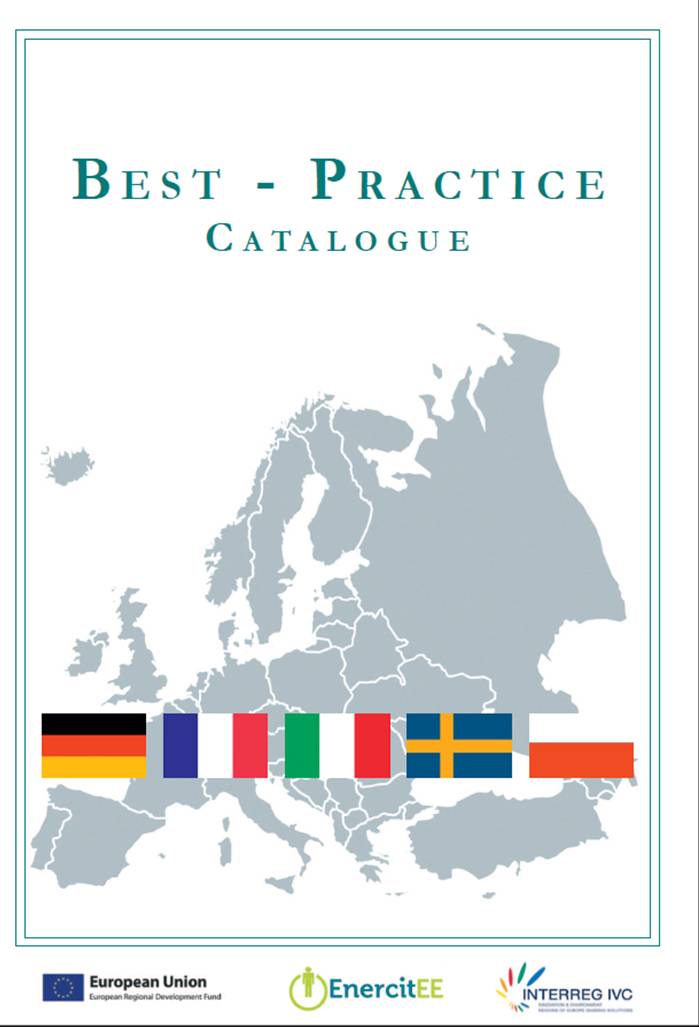Newsletter
- Issue VIII / November 2013
- Issue VII / June 2013
- Issue VI / February 2013
-
Issue V / June 2012
- Editorial: Important milestones have already been reached within EnercitEE
- EnercitEE’s Policy maker exchange – mayors from 4 European countries shared the vision of Växjö
- 2nd EnercitEE symposium
- EnercitEE’s Policy Advice Seminar
- EnercitEE’s Good Practice Guide now available
- First outputs from 1st call sub-projects
- News from EnercitEE’s sub-projects from the 2nd call
- EnercitEE Publicity material
- Upcoming events
- Issue IV / November 2011
- Issue III / July 2011
- Issue II / January 2011
- Issue I / September 2010
First outputs from 1st call sub-projects
CLIPART is delivering
At the end of 2011 the Initial CLIPART Report was ready, basically in form of a wiki web site (clipartwiki.wikispaces.com).

An edited and more readable version of the ICR is due within June 2012, in the form a pdf file downloadable from the Enercitee CLIPART web page (www.enercitee.eu/CLIPART). By the end of 2012 also the Final Report (the CLIPART Handbook) will be ready and available in English, Italian, German, French and Polish to enhance its circulation in the countries of the CLIPART partners and possibly others. The ICR e.g. contains a collection of 51 examples of existing know-how and best practices about climate change mitigation and adaptation initiatives and/or energy and environmental policies from the five project partners at their level of governance (regions and/or local authorities).
Article in full length on the EnercitEE blog.
LEEAN – Best Practice Catalogue now available
The LEEAN project has compiled a Best-Practice-Catalogue with respectively 3 good practices per partner from 5 European regions. The main focus of presented best practices is the awareness raising of homeowners or tenants concerning energy efficiency. It also includes examples for motivating municipalities to save energy. LEEAN strives to sensitize municipality teams, donors, energy agencies and organizations about energy efficiency.
The Best-Practice-Catalogue is available on the EnercitEE website.
PraTLA – The exchange of students’ experiences between regions is the central focus of PraTLA’s final stage
The Sub-project will end at 31st October 2012. Since the beginning of 2011 until now, approximately 58 practical trainings of students in local authorities in 4 different countries have been carried out and will soon be successfully completed. Students got a first insight into local administrational structures and local authorities learned to set up strategies regarding energy efficiency using the students’ knowledge as energy experts for these tasks. Now, the knowledge gained by the trainings will be transferred to the public and the interregional level. The exchange of experience between the regions in this process is a crucial aspect of all partners. For instance, two Swedish projects carried out by German students were presented at conferences in Saxony and Poland. Further joint events are already planned.

Article in full length on the EnercitEE blog.
RIEEB - energetic investigation in Saxony is almost complete
RIEEB’s main goal is the review and support of the Energy Saving Ordinance (EnEV) in Saxony as well as improving and facilitating the examination and admissibility of construction projects by the responsible construction authority and the qualification of authorized persons. Currently samples of four non-residential buildings in Saxony are being evaluated by external experts. In a summarized total evaluation for each report, results of the individual examination are presented and frequent errors are assessed. In the total evaluation conclusions are made regarding typical errors by using the Energy Saving Ordinance and the calculation of energy demand values. The results will be published in a final brochure and will help other EU-countries to simplify future EU investigations regarding the implementation of energy certificates.

Thermographic investigation of the building envelope Project House MeTeOr University Chemnitz
More results of RIEEB will be political recommendations regarding the achievement of Saxon and European climate protection targets. To reach this goal typical errors concerning complex calculations of the Energy Saving Ordinance as well as discrepancies related to the constructional implementation will be pointed out. Also possibilities for future supervision and the compliance of practicality, workload and reasonableness of the Energy Saving Ordinance will be taken into account. Using this knowledge a plausibility tool for municipal and regional construction authorities and building experts will be developed to evaluate the compliance with the Energy Saving Ordinance. This evaluation tool is expected to be available mid 2013 at the Saxon Energy Agency – SAENA GmbH.
SCC – the sustainable climate challenge – gathered 12 good practices from 4 regions
The goal of SCC is to challenge citizens to become more energy efficient, involving public partners and companies to support them to achieve this challenge. Four main fields are tackled: mobility, energy efficiency, CO2 emissions and behavior change.

SCC partners have gathered a list of 12 good practices on these issues to help people to get and implement new ideas. The SCC good practice list is available on the EnercitEE website.
SustraMM – over 15 000 citizens have been reached by local pilot projects
The SustraMM project focuses on sustainable transports and has already organised 3 training courses for city administrators and stakeholders on carpooling, bicycle and electric bicycles. The city of Cluses/France and Pirna/Germany, as well as the Energy Agency for Southeast Sweden and the Technical University of Dresden have been exchanging experience thanks to two interregional meetings, web meetings and study visits.

Twelve Mobility Management good practices have been identified and are being gathered in a brochure. Over 15 000 citizens have been reached by local pilot projects such as bicycle campaign, new city bus line and the Mobility Week.
Further information: www.enercitee.eu/SustraMM.

